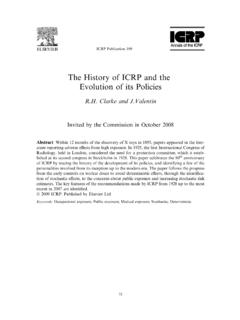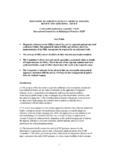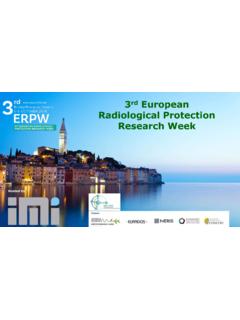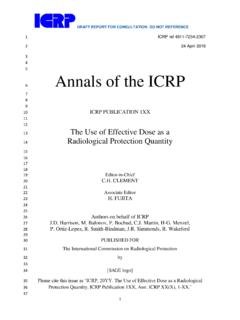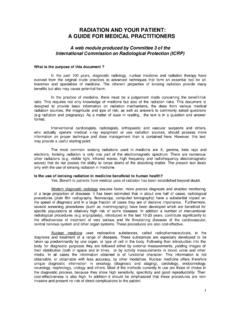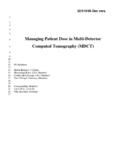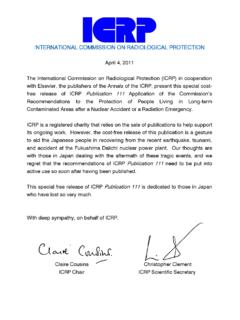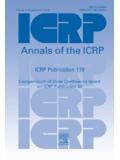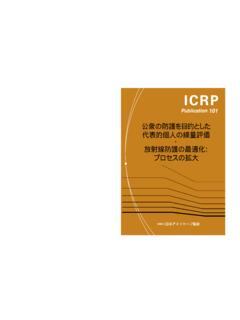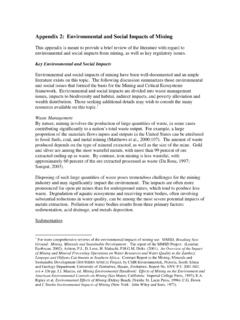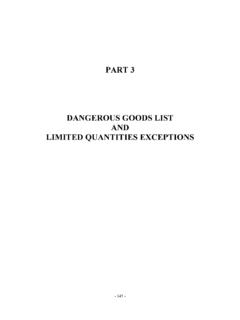Transcription of The Use of Dosimetric Quantities in Radiological ...
1 21/110/05 DRAFT FOR DISCUSSION INTERNATIONAL COMMISSION ON Radiological PROTECTION COMMITTEE 2 BASIS FOR Dosimetric Quantities USED IN Radiological PROTECTION Task Group of ICRP Committee 2: Guenther Dietze Keith Eckerman Hans Menzel John Stather Christian Streffer, Chairman Corresponding Members: W. Alberts, M. Balonov, V. Berkovski, A. Bouville, A. Edwards, J. Harrison, J. Lipzstein, M. Pellicioni, A. Phipps, A. Pradhan DRAFT DOCUMENTI nformation in this document is preliminary and only for internal use by ICRP. This document should not be cited in any published material in advance of final approval by the Commission of ICRP. April 14, 2005 2 Contents Background 1. Introduction 2. Health effects Stochastic Effects Tissue Reactions 3.
2 Dose Quantities in Radiological protection Absorbed dose Averaging of absorbed dose Radiation-weighted dose and effective dose Operational Quantities 4. Weighting factors Radiation weighting factors Tissue weighting factors 5. Practical application in Radiological protection Radioactivity and committed dose Occupational exposure Public exposure Application of effective dose Reference persons Conversion coefficients for external exposure Committed effective dose coefficients from internal exposure Collective dose 6. Uncertainties and judgements in Radiological protection 7. References 8. Glossary 9. Tables 10. Figures April 14, 2005 3 Background For establishing principles and systems of Radiological protection, Dosimetric Quantities are needed in order to assess the radiation exposures of humans as well as other organisms in a quantitative way.
3 The quantification of radiation doses for exposed populations or experimental animals is also important for developing dose-response relationships for radiation effects which are the basis for risk estimation. By extrapolation, such relationships can be used over wider dose ranges than those for which data are available, particularly in the low dose range which is important for Radiological protection. The development of health effects caused by ionising radiation starts with the physical processes of energy absorption in biological tissues, which leads to ionisations with molecular changes which may occur in clusters, in the genetic information of cells, the DNA in the cell nucleus. Other interactions with cells may also be important in understanding the tissue response to radiation exposure. Such damage includes communication between cells, termed bystander effect and may involve the transmission of genomic instability.
4 However, the information on the implications of such responses in terms of the overall tissue effects is unclear at present and it is concluded in the Committee 1 Foundation Document (FD-C-1) that such effects cannot at present be taken into account in dose and risk assessment for protection purposes. For assessing radiation doses from external radiation exposures and from intakes of radionuclides special Dosimetric Quantities have been developed by the International Commission on Radiological Protection (ICRP) and by the International Commission on Radiation Units and Measurements (ICRU). The fundamental Dosimetric Quantities adopted by ICRP are based on measures of the energy imparted to organs and tissues of the human body. A set of such Quantities was adopted by ICRP in its 1977 Recommendations and further developed in the 1990 Recommendations.
5 Based on absorbed dose averaged over an organ or tissue these Quantities were the equivalent dose, effective dose and the subsidiary Quantities committed dose and collective dose (ICRP 1991). These are not Quantities that can be measured directly. The protection system therefore also includes operational Quantities . ICRU has developed a set of measurable operational dose Quantities for exposure to external radiation which have been evaluated by a joint Task Group of the ICRP and the ICRU (ICRP 1996). The analysis by the Task Group indicated that the operational dose Quantities recommended by ICRU generally achieve the objective of providing measurable Quantities that adequately represent the protection Quantities . For internal exposures following intakes of radionuclides activity Quantities in combination with dose coefficients developed by ICRP are also used as operational Quantities .
6 In the light of new scientific data and to make the system of Radiological protection more coherent and understandable, ICRP has decided to develop the system further. A Working Group of Committee 2 was asked to prepare a Foundation Document describing the development of the Dosimetric Quantities to be adopted in the new Recommendations of ICRP. The following text describes the system and provides some background to its development. April 14, 2005 4 1 Introduction Exposure of the cells and tissues of the human body to ionising radiations can result in both short term and long term health effects. At high doses acute damage to organs and tissues mainly arises as a result of loss of function involving cell killing and in extreme cases can cause death of the exposed individual. This type of damage is now termed tissue reactions by the ICRP having previously been called non-stochastic effects in ICRP Publication 26 (1977) and deterministic effects in ICRP Publication 60 (1991).
7 At lower doses and at low dose rates these tissue reactions are usually not seen, but damage to the genetic material may occur that can result in an increase in the risk of cancer many years later or hereditary disease in future generations. Such damage continues to be termed stochastic as the probability of the effect, but not its severity is assumed to increase with dose. Radiological protection is concerned with controlling exposures to ionising radiation so that acute damage is prevented and the risk of long term health effects is limited to acceptable levels. The specific protection Quantities that ICRP has developed for Radiological protection allow quantification of the extent of exposure to ionising radiation from both whole and partial body external irradiation and from intakes of radionuclides.
8 They are based upon assessment of the energy imparted to organs and tissues of the body. The estimated doses can then be compared with recommended dose limits for people who are occupationally exposed and for members of the public. The protection system also includes operational Quantities used in monitoring and practical applications for investigating situations involving external exposure and intakes of radionuclides. For demonstrating compliance with exposure limits, there would preferably be one single Dosimetric quantity specifying the "amount" of whole or partial body exposure which is quantitatively related to the probability of an effect for all types of radiations, regardless of whether the radiation is incident on the body or emitted by radionuclides within it. This ideal is complicated by variations in the response of organs and tissues to radiations of different quality and by the varying sensitivity to radiation damage of the organs and tissues of the body.
9 These factors influence the response of all members of the population to radiation exposure. They are taken into account in the protection Quantities using radiation and tissue weighting factors. Other factors including gender, age and individual sensitivity will influence the individual risk but such biological phenomena are not taken into account for the definition of the Dosimetric Quantities . ICRP first introduced a single protection quantity, effective dose equivalent, in Publication 26 (1977). This was developed principally for use in occupational exposure although it has been used more broadly for members of the public. It was intended to be used for exposure limitation and risk management at low doses. ICRP further developed this concept in Publication 60 (1991) with the quantity effective dose.
10 The underlying principle was to use the absorbed dose as the fundamental physical quantity, to average it over specified organs and April 14, 2005 5tissues and then to apply suitably chosen weighting factors to take account of differences in biological effectiveness of different radiations and the differences in radiation sensitivities of organs and tissues to stochastic health effects. The development of the effective dose equivalent and subsequently the effective dose quantity has made a very significant contribution to Radiological protection as it has enabled doses from external radiation and from intakes of radionuclides to be summed to demonstrate compliance with dose limits. The effective dose as defined in Publication 60 (ICRP 1991) has been implemented into legislation and regulations in many countries worldwide.
